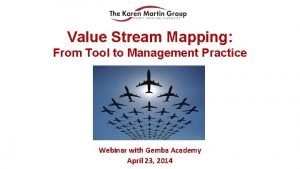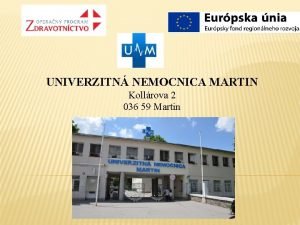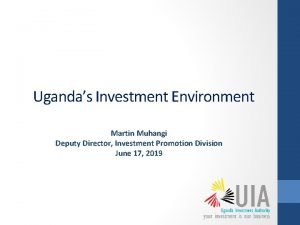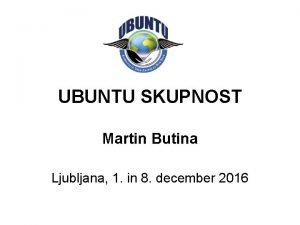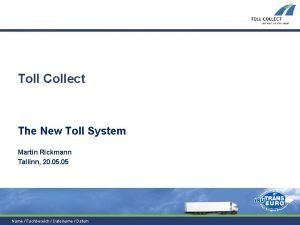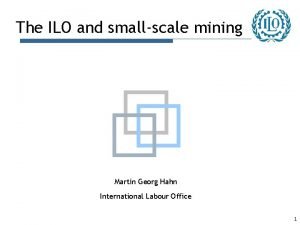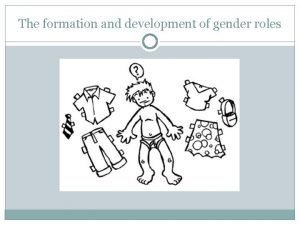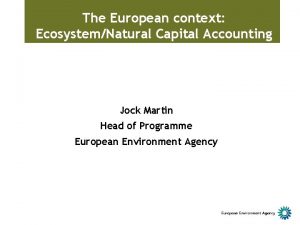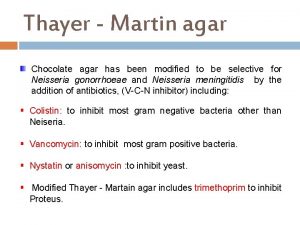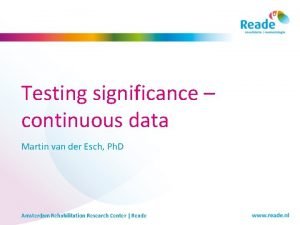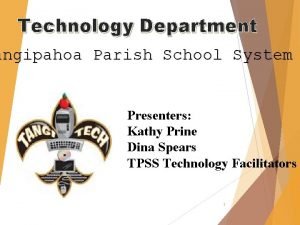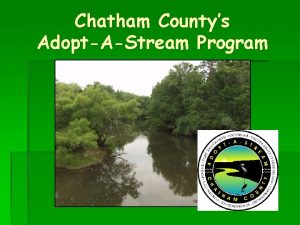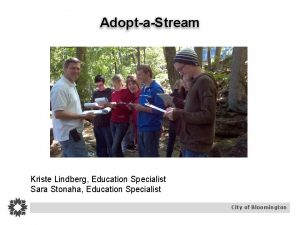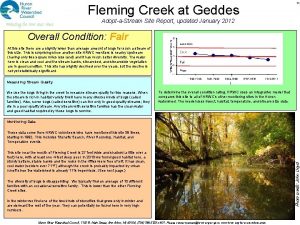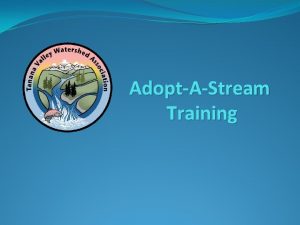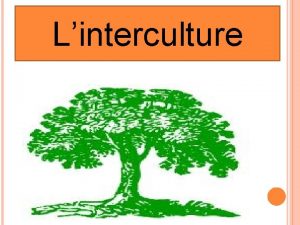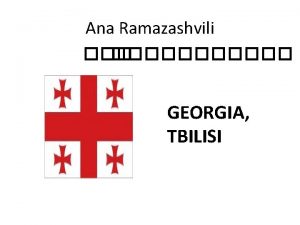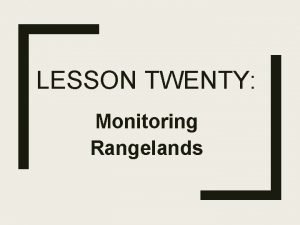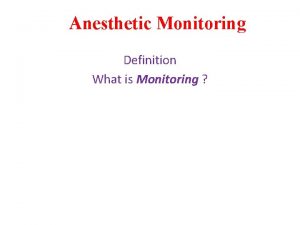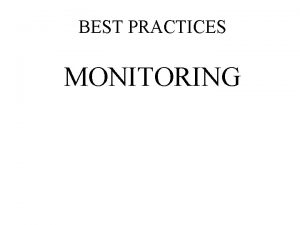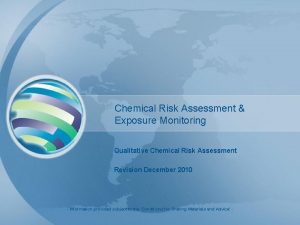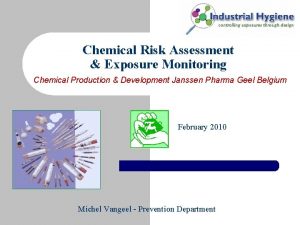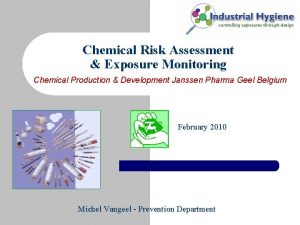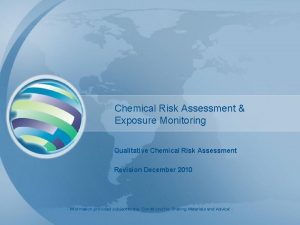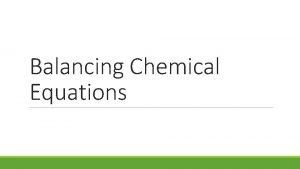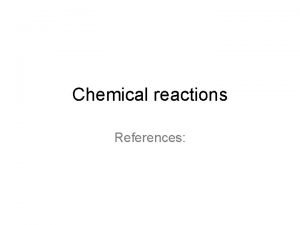Georgia AdoptAStream Chemical Monitoring Georgia AdoptAStream 2 Martin



























- Slides: 27

Georgia Adopt-A-Stream Chemical Monitoring Georgia Adopt-A-Stream 2 Martin Luther King Jr. Drive Suite 1462, East Tower Atlanta, Georgia 30334 www. Georgia. Adopt. AStream. com 404. 463. 1511 Revised May 2015

Georgia Adopt-A-Stream § What is it? § Georgia’s volunteer water quality monitoring program § Program Goals A: Increase public awareness D: Collect quality baseline water quality data O: Gather observations P: Encourage partnerships between citizens & local government T: Provide tools & training

Physical/Chemical Monitoring • Purpose: Gather info about specific water quality characteristics • In addition to the basic visual observations and weather information, AAS recommends monitoring these core parameters: v v v Temperature Dissolved Oxygen p. H Conductivity (Stream and Lake) Clarity (Coastal and Lake) Salinity (Coastal) • Nutrient testing, alkalinity, and settleable solids monitoring may be added to your list as interest and equipment allows.

EPA Quality Assurance Project Plan § Quality Assurance Quality Control (QA/QC) § Only individuals are certified § Certification is valid for one year § Volunteers must attend an annual recertification workshop § Only certified volunteers can submit data!

To Become a Certified QA/QC Volunteer… • In the field, volunteers’ methods must achieve results within the duplicate precision rules of those obtained by the trainer • Volunteers must pass a written evaluation with a score of at least 80%

What is a Watershed? § A watershed is the land area from which water, sediment, and dissolved materials drain to a common point along a stream, wetland, lake or river. § Its boundaries are marked by the highest points of land around the waterbody.

Where, When and How Often? • Where: Same site location and in a well mixed area of flowing water • When: Same time of day and during normal flow conditions • How often: At least once a month

Safety Considerations • If conditions are too dangerous to sample… DON’T SAMPLE! • Wait until storm has stopped and strong flow has subsided • Never sample alone • Remember to wear gloves and boots • Use waste bucket to dispose of chemicals! • Receive permission from land owner before going onto private property

TEMPERATURE (°C) Measurement: § In the shade, away from direct sunlight. § Take air temperature before water temperature. § Single measurement for each parameter § Measured in degrees Celsius (°C) State Standards for Water Temperature: § Less than 32. 2°C (90°F) Importance: § Temperature/dissolved oxygen relationship: The higher the temperature, the less oxygen the water can hold. § Life adapts to a narrow range of temperatures. Changes of only a few degrees can affect the life in a stream. § Temperature affects feeding, respiration, and aquatic metabolism.

DISSOLVED OXYGEN (mg/L or ppm) Measurement: • Rinse sampling bottles twice before collecting sample • Take two samples for duplicate precision. • Two samples must be within +/- 0. 6 • If not, take another sample until two are within that range. • Measured in mg/L or ppm (1 mg/L = 1 ppm) State Standards for DO levels: • Average of 5 mg/L • A minimum of 4 mg/L • Trout streams: Average of 6 mg/L and a minimum of 5 mg/L Importance: • Needed for respiration for all aquatic life • Can be altered by other physical/chemical parameters

DISSOLVED OXYGEN • Inversely related to temperature: • As temperature increases, DO decreases • As temperature decreases, DO increases • DO is introduced into water via • diffusion from the atmosphere, • plant metabolism as a waste product of photosynthesis • turbulent mixing (riffles) • DO levels may decrease due to • warm temperatures • an overload of decaying organic matter (due to excess nutrients) • slow moving, deep water

p. H • • • Measure of hydrogen ions (H+) Measured on a 0 -14 scale Pure water has equal amount of H+ and OH- ions and has a p. H of 7 Measurement: • Rinse sampling bottles twice before collecting sample • Take two samples for duplicate precision. • Two samples must be within +/-0. 25 • If not, take another sample until two are within that range. State Standards for p. H: • Between 6 and 8. 5 • Some south Georgia waters may have p. H as low as 3. 5 • In coastal waters, p. H is within state standards and increases (becomes more basic) with increasing salinity. Importance: • Aquatic organisms are sensitive to p. H fluctuations

CONDUCTIVITY (m. S/cm) • • Measures water’s ability to pass an electrical current Conductivity indicates the presence of ions in the water Measurement: • Single measurement for conductivity • Measured in micro. Siemens per centimeter (µS/cm) • Conductivity meter should be calibrated within 24 hours prior to each monitoring event. • Record calibration information on data sheet State Standards: • No regulated level in Georgia • • Georgia generally ranges from 50 to 1500µS/cm AAS advises volunteers to find normal background levels • Closely monitor any deviations

CONDUCTIVITY • Is affected primarily by geology of the area through which the water flows through • Water that flows through granite tends to have lower conductivity • Water that runs through limestone and clay has higher conductivity • What can affect Conductivity levels? • Mining operations – release of iron, copper, cadmium • Agriculture – adds nutrient ions • Sewage effluent – chloride, nitrates, and phosphate • Urban runoff – auto fluids, salts, and chemical

Salinity (ppt) • Measures amount of dissolved salts in water Measurement: • Measured in parts per thousand (ppt) • Refractometer should be calibrated within 24 hours prior to each monitoring event. • Record calibration information on data sheet • Take two samples for duplicate precision. • Two samples must be within +/-1. 0 ppt • If not, take another sample until two are within that range. State Standards: • No regulated level in Georgia • Salinity of seawater is about 35 ppt • Salinity varies depending on tidal stage and freshwater inputs Importance: • Aquatic plants and organisms are sensitive to changes in salinity

Water Clarity • • Measures the transparency or clearness of the water Is affected by algae growth and the amount of suspended particles Measurement: • Instrument: Secchi Disk • Measures Secchi Disk Depth in cm • Take two samples for duplicate precision: • Two samples must be within +/-10 cm • If not, take another sample until two are within that range. State Standards: • No regulated value in Georgia

Water Clarity Importance: • Suspended particles can lower water clarity which can: • Limit the amount of sunlight available for photosynthesis • Damage gills of fish and macroinvertebrates • Suffocate fish and oysters • Disturb filter feeding of organisms • What can affect water clarity? • Natural influences: rainfall, tidal stage, wind algae growth • Human influences: nutrient additions, development, boating and dredging activities

Nutrients • Nitrates • A nutrient found in the water from fertilizers or animal waste. Sewage is the main contributor. • Normal background levels are below 1 ppm • Phosphates • A nutrient found in water from soaps, fertilizer, animal waste, industrial effluent and sewage • Normal background levels are below 0. 1 ppm Excess nutrients can cause algal blooms, affect sensitive macroinvertebrates, and decrease dissolved oxygen levels

Chemical Kit Maintenance & Disposal • Store chemical kits in a cool, dark place. • Replace chemicals when expired or contaminated • Disposal of chemicals: Used: flush down drain (water trt facility) Contaminated/expired: Hazardous waste day or return to AAS/AAW office for disposal • Contact Georgia Adopt-AStream office for replacement equipment or reagents

Chemical specific All monitoring programs

Observations § § § § Flow/Water Level Water Clarity Water Color Water Surface Water Odor Photos Trash

Chemical Data Form • Use Chemical data form (Chemical/Bacterial combo data form may also be used) • Remember: • Check expiration dates of reagents • Duplicate precision for p. H and Dissolved Oxygen • Calibration information for conductivity meter

Submit the Data § As soon as possible after monitoring is complete § Data should be submitted to the state’s online database: www. Georgia. Adopt. AStream. org § Share your data with partners, local governments and your local Adopt-A-Stream coordinators

In the Database: Site, Weather, Observations

In the Database: Chemical Data

Volunteer Monitoring Data Uses • • Source: National Directory of Volunteer Environmental Monitoring Programs, 5 th Edition Local water departments City Councils Colleges and Universities Forestry Services Environmental Groups Riverkeepers Consulting Agencies Local and State Government

Just the Facts • Raise Awareness Once a month • Water quality Data • Gather Observations • Encourage Partnerships • Provide Tools and Training Well mixed area and at the same time of day Temperature and DO Conductivity: The ability of water to carry a current. Is affected by mining, agriculture, sewage effluent, urban runoff. p. H in South GA Water clarity and plant growth Care for your kit Data: on-line database as soon as possible, local program, city & county government & municipality, partners, county commissioners, universities, others? What is a watershed? Excess Organic Matter: Causes a decrease in dissolved oxygen levels How is oxygen introduced into water? Temperature: importance of, where to measure… Parameter State Standards Duplicate Precision Units Dissolved Oxygen p. H Salinity Clarity (Secchi Disk) Avg of 5, not <4 6 -8. 5 +/- 0. 6 +/- 0. 25 +/- 1. 0 +/- 10 Mg/L or ppm ppt cm When to calibrate? Coastal Volunteers Coastal and Lake Volunteers
 Lockheed martin georgia
Lockheed martin georgia Section 2 classifying chemical reactions worksheet answers
Section 2 classifying chemical reactions worksheet answers Empirical formula pogil
Empirical formula pogil Section 2 classifying chemical reactions
Section 2 classifying chemical reactions Section 1 chemical changes
Section 1 chemical changes Formula of love
Formula of love Chapter 18 chemical reactions balancing chemical equations
Chapter 18 chemical reactions balancing chemical equations Martin doolaard
Martin doolaard Smartfindexpress martin county
Smartfindexpress martin county Martin cors
Martin cors Martin chudjak
Martin chudjak Value stream mapping karen martin pdf
Value stream mapping karen martin pdf Kollárova 2 martin
Kollárova 2 martin Martin muhangi
Martin muhangi Martin muhangi
Martin muhangi Martin butina
Martin butina Theme of i will always write back
Theme of i will always write back Martin rickmann
Martin rickmann Timeline of martin luther king jr
Timeline of martin luther king jr The reformation outcome: martin luther and the reformation
The reformation outcome: martin luther and the reformation What drove martin luther to write the 95 theses
What drove martin luther to write the 95 theses What is ethos in literature
What is ethos in literature Martin georg hahn
Martin georg hahn Martin & halvorson (1983) strengths and limitations
Martin & halvorson (1983) strengths and limitations Jock martin
Jock martin Agar thayer martin chocolate
Agar thayer martin chocolate Martin van der esch
Martin van der esch Tangi school board
Tangi school board











